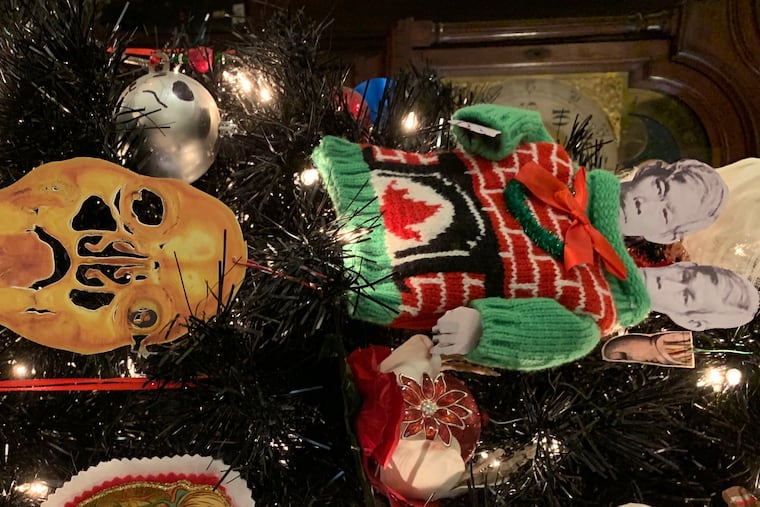With a giant smiling colon and wreaths of human hair, this is not your average Christmas tree
“How many times do you walk into an office around the holidays and see a Christmas tree?” said Mütter Museum curator Anna Dhody. “You almost never stop and look. This tree gives you a reason to stop.”

Think your family has odd holiday traditions? Compare them with mini-wreaths made of human hair and an ornament of gingerbread men conjoined at the head.
Those are two of Anna Dhody’s favorite Christmas decorations. “Every ornament you open up is a great time to relive memories,” said Dhody, curator of the Mütter Museum, a medical-history collection in Center City.
The wreaths remind her of a hair art exhibit the museum featured this year. The gingerbread twins pay homage to a display of Chang and Eng, the original Siamese twins. And an ornament called “Santa’s hand in a jar” hearkens back to the perfectly preserved gangrenous hand that belonged to Thomas Mütter’s original collection.
More than 170,000 visitors come to see the museum’s rare medical collection each year, including the wall of skulls and slices of Albert Einstein’s brain. So it’s only fitting that the museum celebrate the holidays in a similar fashion — with a crowd-sourced Christmas tree featuring handmade “Mütter-esque” ornaments highlighting medical marvels and anatomic anomalies.
“How many times do you walk into an office around the holidays and see a Christmas tree?” Dhody said. “You almost never stop and look. This tree gives you a reason to stop.”
The ornaments are donated by museum staff members, their families, and Mütter fans across the country. The series of conjoined gingerbread twins were among the first added to the tree when it went up in 2007. Dhody’s mother made them, along with a patch featuring Skully Claus, the museum’s Santa reincarnate.
Since then, the museum has received a few donations each year, totaling more than 20 unique ornaments on display now.
One ornament, which came all the way from Scotland, shows a cross-section of Santa’s brain. In case you were wondering, there are presents tucked between his neurons.
An orthopedic baby brace was sent from upstate New York, and a poinsettia with skeletal fingers was delivered from Chicago.
“Every time we put the tree out, it’s a time capsule, reminding us of Mütter holidays past,” Dhody said.
Atop the tree sits the Angel of Death — a tradition for the last 11 years. This year, museum director Robert Hicks named the angel Kritana, which means “god of death” in Sanskrit.
Exhibition manager Michael Keys puts up the tree after Thanksgiving and has it inspected by the Plague Doctor (Hicks in costume), who ensures the tree is “Mütter-y enough.”
“It’s a nerve-wracking time,” Keys joked.
The criteria for ornaments to make it onto the tree are fairly loose. A green bauble with eyes and a purple sash qualified because of the mutant aspect of Teenage Mutant Ninja Turtles. It hangs across from a two-headed dinosaur and next to a smiling colon, modeled after the museum’s display of a 40-pound megacolon from the 19th century.
So far, the museum hasn’t received any ornaments that were inappropriate to display. The hair wreaths are the only ones made of actual human remains, Dhody said. “That we know of.”
The museum received donations from two fans this year, said Gillian Ladley, media and marketing manager. A woman from California shipped an anatomically accurate heart ornament, and a local resident hand-delivered an endoscopy-slide ornament and a photo of Chang and Eng in a holiday sweater.
Anyone who wants to donate an ornament can mail it to: Mütter Tree, Mütter Museum, 19 S. 22nd St., Philadelphia, Pa. 19103. Submissions are accepted year-round.
If you’re in need of some inspiration, Dhody said she’d love to see an ornament that lights up on its own. Keys is hoping someone will create an ornament based on the collection of more than 2,000 objects Philadelphia surgeon Chevalier Jackson removed from people’s throats and lungs, ranging from buttons and pins to bones and toys.
“Creating an ornament is one way for people to interpret the collection and be a part of it,” Ladley said.